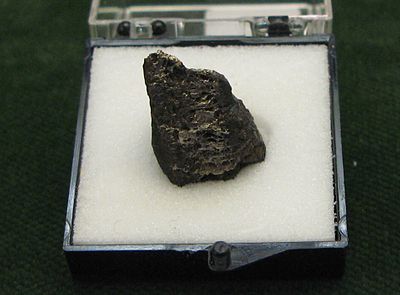Eugenite
| Eugenite | |
|---|---|
| One with Luanheit misshapen Eugenit | |
| General and classification | |
| other names |
IMA 1981-037 |
| chemical formula | Ag 11 Hg 2 |
|
Mineral class (and possibly department) |
Elements - metals and intermetallic alloys |
|
System no. to Strunz and to Dana |
1.AD.15 ( 8th edition : I / A.02) 01.01.08.05 |
| Crystallographic Data | |
| Crystal system | cubic |
| Crystal class ; symbol | 4 3 m |
| Room group (no.) | I 4 3 m (No. 217) |
| Lattice parameters | a = 10.02 Å Please complete the source as an individual reference |
| Formula units | Z = 4 Please complete the source as an individual reference |
| Physical Properties | |
| Mohs hardness | 2.5 to 3 |
| Density (g / cm 3 ) | 10.74 |
| Cleavage | Please complete |
| colour | silvery white |
| Line color | Please complete |
| transparency | opaque |
| shine | metallic |
Eugenite is a very rare mineral from the mineral class of the elements, more precisely the metals and intermetallic compounds. It crystallizes in the cubic crystal system with the chemical composition Ag 11 Hg 2 and forms up to 4 mm large grains of silver-white color, in reflected light with a slight yellow tinge.
Etymology and history
Eugenite was first found in 1981 by H. Kucha in the type locality , the Sieroszowice copper mine near Polkowice in Poland . It is named after the Austrian mineralogist Eugen Friedrich Stumpfl .
classification
In the Strunz system , eugenite is counted among the metals and intermetallic compounds, a subgroup of the elements. After the 8th edition , together with belendorffite , lead amalgam , gold amalgam , kolymite , luanheit , moschellandsbergite , paraschachnerite , potarite , mercury , schachnerite and weishanite form a group. In the 9th edition , it forms a subgroup of the mercury amalgam family with Luanheit, Moschellandsbergite, Paraschachnerite and Schachnerite.
In the systematics according to Dana it forms with lead amalgam, gold amalgam, luanheit, moschellandsbergite, paraschachnerite, schachnerite and weishanite a subgroup (silver-amalgam alloys) of the metallic elements apart from the platinum metals .
Education and Locations
Eugenite is formed in low concentration copper- sulfur ores in shale or carbonate rock . It is associated with chalcosine , covelline , tennantite , hematite , calcite , anchorite and gypsum . In addition to the type locality, other finds are known from Lubin in Poland , near Copiapó in Chile , the province of Ouarzazate in Morocco , Sacha in Russia , Sala in Sweden and Bisbee in the US state of Arizona .
Crystal structure
Eugenite crystallizes in the cubic crystal system in the space group I 4 3 m with the lattice parameter a = 10.02 Å , as well as four formula units per unit cell .
See also
Individual evidence
- ↑ IMA / CNMNC List of Mineral Names (2012) (PDF 1.5 MB)
- ^ New Dana Classification of Native Elements
literature
- Eugenit in: Anthony et al .: Handbook of Mineralogy , 1990, 1, 101 ( PDF ).
- H. Kucha: Eugenite, Ag ll Hg 2 -A new mineral from Zechstein copper deposits in Poland . In: Mineral. Polonica , 1986, 17 (2), pp. 3-10. Abstract in: American Mineralogist , 1995, 80, p. 846 (English, PDF ).
